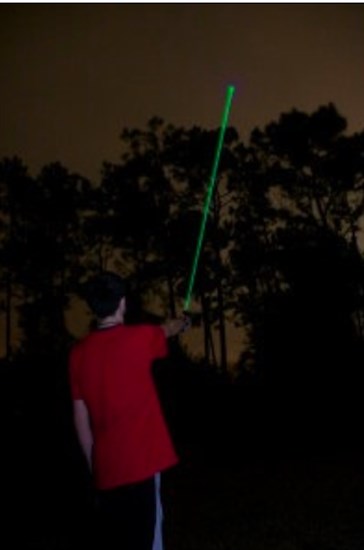
This shows how a laser beam grows in diameter as it travels into the night sky.
Image Credit: Submitted/LaserPointerSafety.com
December 18, 2023 - 6:00 AM
Since 2004 there have probably been 120,000 laser beams hitting aircraft cockpits worldwide, says Florida-based expert Patrick Murphy.
“Roughly about half the people (who do it) are ignorant of it and about half the people are anti-social,” the creator of the LaserPointerSafety.com website told iNFOnews.ca. “They know they’re doing something wrong. They may not like the noise from it or they may be doing some criminal activity and are trying to distract the police helicopter.”
He has compiled data on how many strikes are recorded in various countries and documented many of the convictions for those caught doing it.
Just this year alone, the U.S. is on a trajectory to record more than 13,000 incidents, a 37.6% increase over last year.
His site doesn’t have up-to-date Canadian data but Transport Canada provided counts up to the end of October this year.
Nationally, there were 409 incidents in the first 10 months of this year, a 48% increase from the 276 recorded in all of 2022.
The increase in BC was only 27.4% to 79 in the first 10 months from 62 all of last year. Five of those were hits on aircraft coming in and out of Kelowna International Airport.
READ MORE: Laser attacks on aircraft over Kelowna airport disturbing trend
Murphy explains in some detail, on his website, why people may be shooting lasers at aircraft without realizing it.
“Often, aiming towards aircraft is done because of a visual illusion where a laser beam can seem to end so it looks as if it cannot touch an aircraft,” he wrote. “Also, users may think that the beam won’t be seen by the pilots if it is under or behind the aircraft.
“Finally, even if the beam is aimed at the cockpit, users may think the beam makes a tiny dot of light on the windscreen just like when they play with their cat or highlight a PowerPoint slide. They don’t realize that, over hundreds of feet, a laser beam spreads to become a two-to-three-foot blob of light that blocks pilots’ vision."
That illusion, he explains, is due to something called the Planetary Boundary Layer.
“For a laser beam to be visible, some of the light must reflect off particles such as dust, smoke or water vapour,” Murphy wrote. “In a zone near the Earth’s surface, the atmosphere is full of these aerosols, helping to make outdoor laser beams visible.”

Image Credit: Submitted/LaserPointerSafety.com
That layer can range from a few hundred to a few thousand metres. After that, past the Planetary Boundary, the laser beam is not visible from Earth because there are fewer particles for it to reflect off.
Even with a low-powered laser the beam can travel well over three kilometres while the more powerful ones can travel a dozen kilometres or more.
Murphy’s site also lists convictions from around the world for pointing lasers. Some samples from 2021 range from an $8,000 fine to 51 months in jail.
On the lower end of the penalty scale that year was Jeremiah Belen who hit an FBI surveillance plane in Milwaukee and a Wisconsin National Guard helicopter.
“Belen apologized to the judge during his sentencing,” Murphy wrote. “He said he had the laser for astronomy pointing with his two children. Belen said he aimed at the aircraft because he was bored after being laid off during the COVID pandemic.”
Justin John Shorey, on the other hand, was given 51 months — the maximum sentence is 60 months — for hitting a San Antonio Police Department helicopter three times.
“The light affected the pilot's ability to read his gauges,” Murphy wrote. “While the pilot landed safely, he was unable to fly for a week.”
Most of the convictions he cites are for hits on police aircraft.
“Normally, they’re not going to charge people who just don’t know, who are in their backyard playing with their cat,” Murphy said. “But anti-social people, they’ll be caught with drugs or on probation or whatever it is. Those are the people who will be prosecuted.”
While Kelowna airport officials talk about how lasers could lead to tragedy because they can impair the ability of pilots to read their instrument panels, Murphy doesn’t know of any such consequences.
“It’s certainly a potentially hazardous thing,” he said. “I don’t want to downplay it. But on the other hand,we have not seen the crashes or the other problems that we thought we might see.
“Not that they couldn’t happen and not that we shouldn’t be vigilant and shouldn’t be trying to stop this, but there have been over 100,000 of these... since 2004 worldwide and the FAA (Federal Aviation Administration) doesn’t seem to be that concerned about it. They’re certainly not putting any new resources into it.”
He attributes the dramatic increase in the number of incidents to both the proliferation of lasers and the increase in anti-social behaviour.
Whenever there have been campaigns to stop the practice, it just seems to increase the use of lasers, Murphy said.
Police aircraft often have equipment that can track the laser beams and coordinate with officers on the ground to nab the suspects. But that only really works with helicopters that can hover long enough to take the readings.
There are laser-blocking goggles pilots can wear but they don’t shield them from all laser colours at once and do cut down on visibility at night so are only recommended during volatile situations or where laser use is common.
“There is no single solution to this,” Murphy said. “The best solution, I think, is pilot training on how to recognize and avoid this and know that they’re not going to have their eyes damaged. It just seems, on the ground, we have not been able to stop this. Fortunately, there have been no crashes at all.”
To contact a reporter for this story, email Rob Munro or call 250-808-0143 or email the editor. You can also submit photos, videos or news tips to the newsroom and be entered to win a monthly prize draw.
We welcome your comments and opinions on our stories but play nice. We won't censor or delete comments unless they contain off-topic statements or links, unnecessary vulgarity, false facts, spam or obviously fake profiles. If you have any concerns about what you see in comments, email the editor in the link above. SUBSCRIBE to our awesome newsletter here.
News from © iNFOnews, 2023